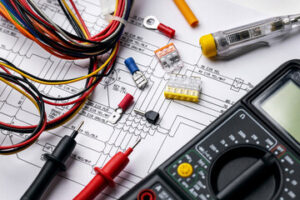Every home, office, and factory requires electrical power. Electricians install and repair the electrical systems that make these places run.

Aspiring electricians often start in the trades by completing an apprenticeship program. These programs can last up to 4-5 years and provide hands-on experience in the field. They are also an excellent option for people who want to avoid the high debt associated with a four-year college degree. Visit https://www.p2electricalcontracting.com/nashville-electrician to learn more.
Electrical wiring is the system that powers lighting, appliances, electrical switches and other devices in your home or office. It consists of insulated wires that are bundled together into a cable. Electricians are able to repair and maintain these wiring systems in residential, commercial and industrial settings.
The wires in a cable are typically colored to help you and your electrician easily identify them. They are also tagged with a number and gauge. The gauge refers to how much electricity each wire can safely conduct.
Most electricians use insulated copper wires that are typically covered by sheathing in different colors. These sheaths protect the wires from heat, water, chemicals, sunlight and other contaminants. The sheaths are also designed to resist abrasion and corrosion. The sheaths and wires are then bundled into a metal conduit to create a finished wiring system.
Typical residential wiring uses insulated wires that are labeled with the letters THHN or THWN, which stand for thermoplastic heat-resistant nylon-coated. This type of wire can withstand harsh conditions and temperatures, making it the most common in homes. THHN and THWN wires are typically bundled into a plastic or metal conduit.
Every home has a service panel that distributes power to each circuit. This is where you can shut off a circuit when you are working on a project or need to do maintenance. The service panel contains the hot wires (usually black or red), neutral wires (typically white) and a grounding wire (usually green). A grounding wire helps reduce fire hazards by providing an alternative path for electricity to follow should one of the other wires become damaged. Grounding wires are also used to connect the electrical system to other metal systems in your home, like plumbing pipes, gas piping and cable TV and telephone lines.
Wiring Connections
Electricians use a variety of tools and techniques to make electrical connections that deliver electricity. They connect wires to outlets, switches and other devices. They also inspect and repair electrical systems to prevent system breakdowns or maximize electrical usability.
Electrical circuits run throughout homes and businesses, supplying power to lightbulbs, appliances and other receptacles. A hot wire (typically with a black casing) runs from the home’s electrical panel to lightbulbs, outlets and other receptacles, while a common wire returns current to the electrical panel. A grounding wire is also necessary to protect against shocks and fire hazards.
Whenever connecting new or old wiring, electricians follow a specific set of rules to ensure safety and optimal electrical performance. For instance, they strip the insulation off the ends of the wires before attaching them to an outlet or switch. They also use terminals that are rated for the size of the wires or cables they’re joining. The use of improper connections can result in an electrical short, which is dangerous to everyone in the space.
When working on electrical wiring, it’s important to turn off the power at the main circuit breaker before starting work. It is also essential to always test a connection after making it to ensure that it’s secure.
If you’re interested in becoming an electrician, you should enroll in a vocational school to learn the skills and knowledge needed for this career. Ashworth College offers a program that includes an apprenticeship opportunity, so you can get hands-on experience under the supervision of a licensed professional electrician. Contact an Admissions Advisor today to learn more about how you can start your path toward a career as a skilled electrician!
Electrical Outlets
A wall outlet (also called an electrical socket or receptacle) is an opening in the wall where you plug in electronic devices and appliances. There are many different types of outlets with a variety of special features to help ensure safety and convenience.
For example, some outlets have built-in surge protection to prevent power spikes that can damage connected electronics. Others have a third prong that allows you to safely plug in three-prong electrical devices. And you can find tamper-resistant outlets that prevent you from inserting foreign objects into the slots, such as paperclips or keys. Some outlets also have arc fault circuit interrupter (AFCI) technology that detects electrical problems such as overheating and shuts off the outlet’s power to prevent fires.
If you need to replace an outlet, it’s important to hire a licensed electrician to ensure that the wiring is safe and that your new outlet is properly grounded and wired. To install a new outlet, the electrician will start by marking the location on the drywall and cutting a hole in the wall. They’ll then turn off the power to the outlet at the main electrical panel for safety, and remove the old outlet by unscrewing it and stripping about an inch of insulation from the electrical wires with a pair of wire strippers (also known as pigtails).
Once they’ve finished installing your new outlet, they’ll connect the wiring and test it for any issues such as overheating. If they identify any problems, such as loose connections or frayed wires, they’ll repair them and test the outlet again.
Electrical Switches
An electrical switch is an electromechanical device that disconnects or connects the conducting path in an electric circuit. The actuating element may be a lever, handle, rocker, or button. The main property of an electric switch is its ability to change from one condition to another, namely from the “on” state to the “off” state.
There are several different types of electrical switches, but they all have some common features. For example, all have terminals to which electrical wires are attached. In some cases, the switch may also have an internal mechanism to help ensure that the contacts touch when closed. This helps to minimize the risk of an arc, which can cause damage to the switch and to other components in the circuit.
The most common type of electric switch is a single-pole, single-throw (SPST) switch. This is the standard light switch in most homes. Other types of switches include a three-way switch, which is typically used in pairs on staircases or in garages or basements with two entrances, and a four-way switch, which is usually used to control one light fixture or appliance from multiple locations.
Some electric switches can be controlled remotely using a hub or voice automation system, but most require a neutral wire connection because they need to draw a small amount of current for operation. There are also smart switches that work without a neutral connection, but they often require a circuit upgrade. Some of these switches can also be paired with other smart devices to form a home network. Power electronic devices are a crucial part of any electric switch, so there are many different models available for use in real-time simulation. Each model has advantages and disadvantages, but the model chosen must be carefully selected based on the accuracy required and the computing time available.
Electrical Circuits
Billions of appliances and devices rely on electric circuits for their operation. As an electrician you will need to know how electric circuits work and how to put them together. You will also need to understand electrical terms and concepts, like current, voltage, fuses and switches.
The basic elements of an electric circuit are a power source, a conductor that connects the source to the load and switches that allow you to control the flow of electricity through the circuit. Wires are the most common conductors and are made from metals like copper and aluminum, which have low resistance to current. The switches let you open and close the circuit. The fuses, which are designed to break the circuit if too much current passes through it, protect the devices and people from dangerous levels of electricity.
A common way to think of a circuit is the battery and light bulb example that shows how charged particles move from the negative end of the battery to the positive end of the light bulb through conducting wires. Electricians use circuit diagrams to draw schematics of electric circuits, which are not lifelike depictions but simplified, standardized representations. Each circuit element is represented with a symbol and wires connecting those elements are represented by lines.
In electrician lingo, there are two types of electric circuits: a series circuit and a parallel circuit. A series circuit is where the elements are connected in a row and there is only one path for electricity to travel through the circuit. If any of the elements break, the circuit is broken and the device will not operate. A parallel circuit, on the other hand, is where the devices are connected in a grid and each device gets an equal amount of electricity.
